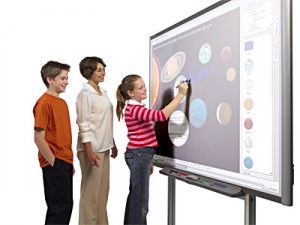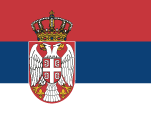The implementation of electronic interactive whiteboards, also known as IWBs, transforms the traditional, reproductive teaching into interactive teaching that corresponds to the needs of contemporary students and leads to learning outcomes that are in accordance with the demands of the modern society.
This form of teaching motivates the students and maintains their attention, since the students can be more involved, instead of focusing on writing notes. The use of various knowledge resources enriches the classroom content and develops the students’ abilities in a number of ways.
The implementation of this kind of teaching requires a computer, a projector, and a projecting surface that can be used to present, write, draw etc. Input methods include specialized pens, as well as fingers, with plenty of room for creativity depending on the teaching objectives and the age group in question. Interactive whiteboard sends information to the computer, which, in turn, projects the image onto the IWB, in a series of smooth steps of feedback which ensure a seamless experience to the presenter and the audience alike.
As explained at the recent international conference “Technology and informatics in education” in Belgrade, the use of interactive boards allows for a greater participation from the students, while the teachers can diversify their content and their methods. This adapts the teaching process according to the students’ learning styles and makes it easier for the students to better understand even the most complicated tasks, thanks to the clear, dynamic and efficient presentations that develop students’ and teachers’ digital skills, all the while increasing the creativity and the motivation for learning involved.
 The use of interactive whiteboards in creating teaching material allows the teachers to use documents from various programs on board, to mark, enlarge and highlight the text using the reflector function, as well as use other options to emphasize the important content. IWBs also allow the teachers to save all the changes made during the lectures, or to keep the presentation in its original form, in order for the teaching process to be adapted anew to the students’ needs in the next lecture.
The use of interactive whiteboards in creating teaching material allows the teachers to use documents from various programs on board, to mark, enlarge and highlight the text using the reflector function, as well as use other options to emphasize the important content. IWBs also allow the teachers to save all the changes made during the lectures, or to keep the presentation in its original form, in order for the teaching process to be adapted anew to the students’ needs in the next lecture.
On interactive boards, you can use pens or fingers to write or draw various shapes that can be easily recognized as regular geometric shapes and simple motion can be used to distribute elements on the board, which is particularly important with schematics.
Furthermore, during the presentation, one can connect to other pages of the workspace, as well as connect to other documents and programs on the computer and the Internet. This option provides the necessary dynamics in the teaching process and it allows the teachers to use a large number of examples, which are crucial for the development of practical knowledge and skills.
The implementation of interactive whiteboards at ITS renders the teaching and learning dynamics both more exciting and more meaningful. The teachers can be more creative when composing their teaching materials, as well as store and distribute the materials more easily, while the students have significantly more room for active involvement in the process.
Students do not need to worry about writing notes or focusing their attention; they can relax and actively participate in the process.
